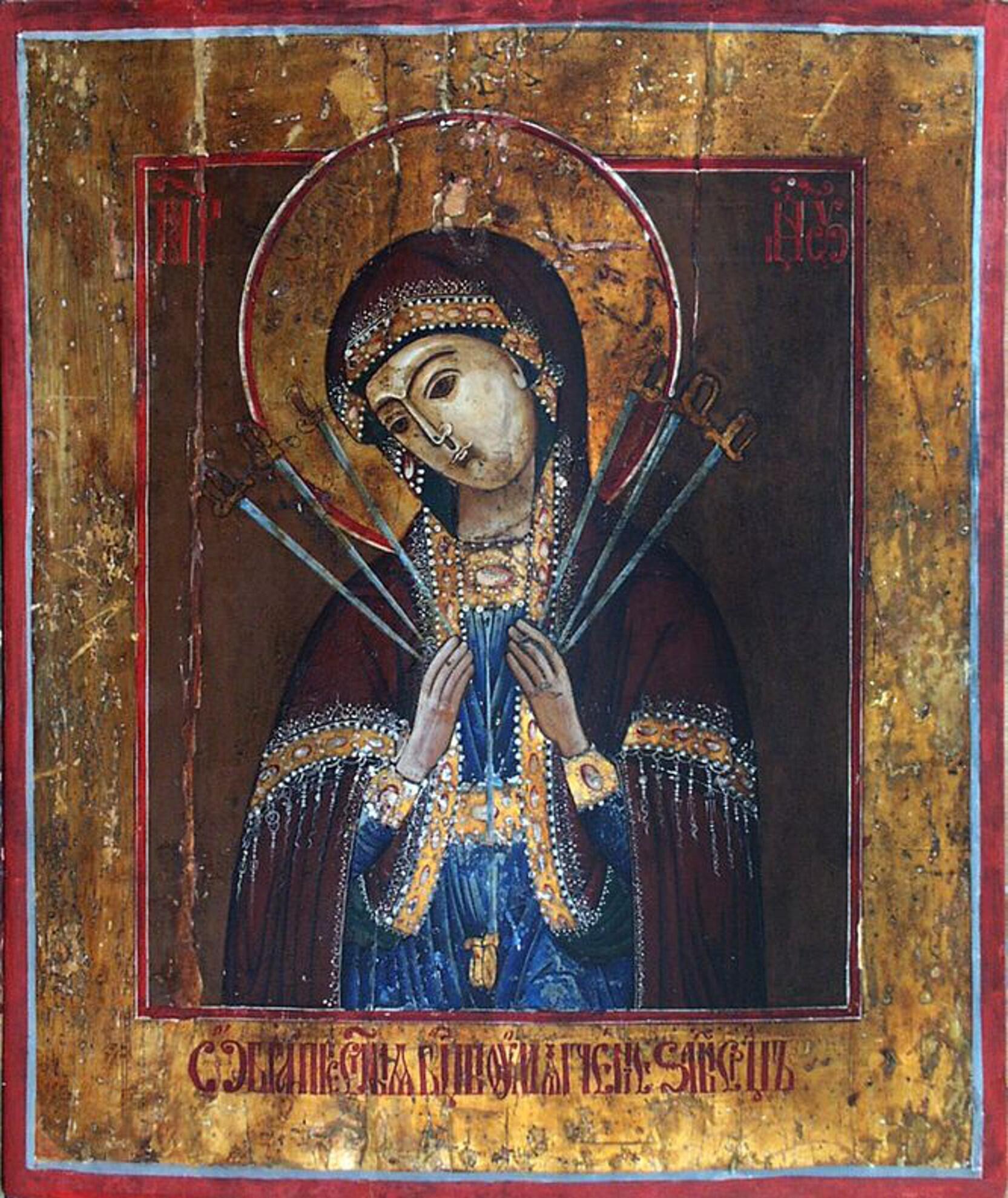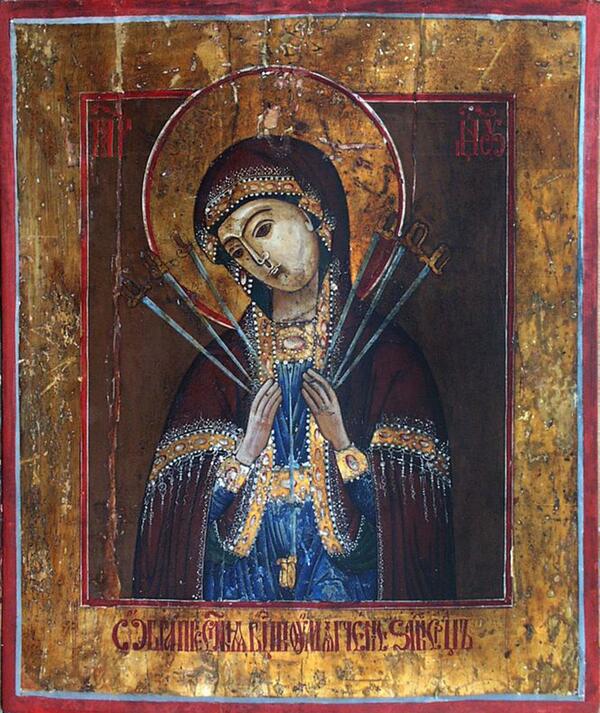The composition of the icon of the Mother of God displayed in the Tomsk Museum follows a particular iconographic type of called ‘Softening of Evil Hearts’. The composition which usually includes seven swords became popular in the second half of the 19th — early 20th century. A distinctive feature of these icons is the position of Mary’s maforium (a long cape), which is open at the chest, so that the neckline and belt of the dress are visible. Unlike other icons, the pierced blue swords with large gold hilts are depicted in this icon with convincing realism.
Earlier, in the 15th-16th centuries, Western European artists painted the maforium-cape on the shoulders of their Madonnas exactly in this manner. With her hands pressed to her chest, Virgin Mary covers the points of the three swords which are pierced through her heart on each side. The long blade of the 7th sword almost merges with the folds of her bright blue dress.
The image of Mary is painted on gold leaf laid over a reddish-brown polymer clay — an adhesive base for gilding. Not only the hilts of the terrible “swords that pierced the heart” of Mary were gilded, but also the wide brim and halo, as well as the stripes of the collar, belts, cuffs of the dress and the borders of the maforium. The robes are lavishly embellished with large convex “precious stones”, thin white lace, and long fringe.
The pronounced eastern features of the face of the Virgin Mary suggest that the icon was created for baptized Siberian “inorodtsy” — the indigenous inhabitants of Siberia. These included the Altaians, the Khakas, the Evenks and other peoples. The “sable” eyebrows which meet on the bridge of the nose, the almond-shaped eyes, and the upper lip in the form of a graphic letter “m” for them were the standard of female beauty. The face of the Mother of God here resembles a motionless mask. This effect is created by an unusual technique: dense brush strokes of white paint were applied on top of the diluted ochre.
At the end of the 19th century, Altai nuns received initial training in icon painting in monasteries of both capitals. It was the initiative of St. Macarius of Tomsk, the head of the Altai Holy Mission. Due to his efforts, schools, a catechetical school for local peoples, an orphanage, a convent and a workhouse for the poor were opened in the Altai region. Even when he worked in Moscow, Macarius directed all his personal money to the development of the monasteries of his native land. If the researchers are correct in their hypothesis that the icon was painted by local nuns, it becomes clear how a rather specific icon, which is not very skillfully made, could have been painted on expensive gold leaf.
If the icon was in fact painted by the nuns, then it is the first known monument of icon painting created at Nikolsky Women’s Monastery in Ulala (presently — Gorno-Altaysk).
Earlier, in the 15th-16th centuries, Western European artists painted the maforium-cape on the shoulders of their Madonnas exactly in this manner. With her hands pressed to her chest, Virgin Mary covers the points of the three swords which are pierced through her heart on each side. The long blade of the 7th sword almost merges with the folds of her bright blue dress.
The image of Mary is painted on gold leaf laid over a reddish-brown polymer clay — an adhesive base for gilding. Not only the hilts of the terrible “swords that pierced the heart” of Mary were gilded, but also the wide brim and halo, as well as the stripes of the collar, belts, cuffs of the dress and the borders of the maforium. The robes are lavishly embellished with large convex “precious stones”, thin white lace, and long fringe.
The pronounced eastern features of the face of the Virgin Mary suggest that the icon was created for baptized Siberian “inorodtsy” — the indigenous inhabitants of Siberia. These included the Altaians, the Khakas, the Evenks and other peoples. The “sable” eyebrows which meet on the bridge of the nose, the almond-shaped eyes, and the upper lip in the form of a graphic letter “m” for them were the standard of female beauty. The face of the Mother of God here resembles a motionless mask. This effect is created by an unusual technique: dense brush strokes of white paint were applied on top of the diluted ochre.
At the end of the 19th century, Altai nuns received initial training in icon painting in monasteries of both capitals. It was the initiative of St. Macarius of Tomsk, the head of the Altai Holy Mission. Due to his efforts, schools, a catechetical school for local peoples, an orphanage, a convent and a workhouse for the poor were opened in the Altai region. Even when he worked in Moscow, Macarius directed all his personal money to the development of the monasteries of his native land. If the researchers are correct in their hypothesis that the icon was painted by local nuns, it becomes clear how a rather specific icon, which is not very skillfully made, could have been painted on expensive gold leaf.
If the icon was in fact painted by the nuns, then it is the first known monument of icon painting created at Nikolsky Women’s Monastery in Ulala (presently — Gorno-Altaysk).



